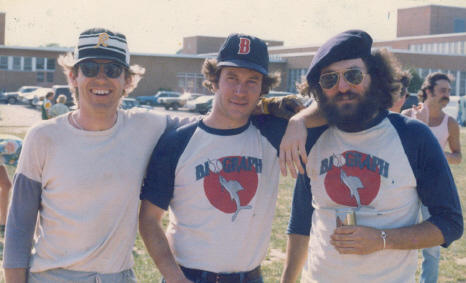 |
| L-to-R: Chuck Wrenn, Terry Rea, Larry Rohr. |
In the Biograph Theatre's first year of softball we called our team the Swordfish. The nickname came from a
joke in a Marx Brothers movie. The amazingly lucky Swordfish won 15 games of
the 17 we played in 1976. (We never had another season with such
success.) The two losses that summer came in memorable situations. The first was the championship game of the Fan District Softball League's Invitational Tournament. The second was played inside the walls of
the old state penitentiary against the home team.
Located at Belvidere and Spring Streets, the fortress prison
loomed over the rocky falls of the James River for nearly 200 years.
As it happened, the guy in charge of recreation at the pen frequented
a favorite watering hole of mine -- J.W. Rayle (located at Pine and Cary from 1974-77). During a conversation there he asked if the Swordfish might like to take on the prison’s softball team on a Saturday
afternoon. He went on to say that Chuck Wrenn of the Rayle team had already agreed to do so.
Without much thought, I followed suit. Then, as it turned out, the first date we set
up was canceled, due to something about a small riot. Well...
OK.
Nonetheless, a
couple of weeks later the Rayle and Biograph teams entered the Big House. To get
into the prison yard we all had to go through a process, which included a
cursory search. We had been told in advance to bring nothing in our pockets.
As
we worked our way through the ancient passageways, sets of bars were
unlocked and then locked behind us. Each of us got a stamp on our
hands that could only be seen under a special light. Someone asked
what would happen if the ink got wiped off, inadvertently, during the
game. He was told that was not a good idea.
OK.
Rayle played the prison team first, then the
Biograph. The
umpire for the games was Dennis “Dr. Death” Johnson, a rather high-profile character at the time. Johnson played on another Fan District team.
Among other things, he did some professional wrestling, so he
was quite good at hamming up the umpire's role.
The fence in left
field was the same high brick wall that ran along Belvidere Street.
It was only about 230 to 240 feet from home plate. Yet, because of
its height, maybe 30 feet, a lot of hard-hit balls caromed off of it.
What would have been a routine fly ball on most fields was a home run
there. It was a short, red brick version of Boston’s Green Monster.
The
prison team, known as the Raiders, was quite good at launching
softballs over that towering brick wall. They seemed to have an
unlimited budget for softballs, too. Under the supervision of
watchful guards, about 75 other prisoners seated in stands
along the third base line cheered for the home team. Actually, they cheered for
any good plays in the field. They cheered the loudest for a sliding collision at third base.
During a conversation with a couple of my teammates behind
the backstop, I referred to the home team as “the prisoners.” Our
opponents’ coach, who was within earshot, immediately stepped
toward me. Like his teammates, he was wearing a typical polyester softball
uniform of that era with “Raiders” emblazoned across their chests in a
script and number on their backs.We wore what were the latest cotton Biograph T-shirts.
“Call us the Raiders,”
the coach advised, sternly, as he pointed to a rather awkward-looking
mural on the prison wall that said, “Home of the Raiders.” It
looked sort of like a jailhouse tattoo, blown up large. Anyway, it was
obvious, I had made a faux pas.
“While we are on this
ballfield, we’re not the Prisoners,” he said with, ah,
conviction. “We’re the Raiders.”
“Raiders,” I said.
“Right.”
“And, all our games," he deadpanned, "are home games.”
We all laughed, grateful the tension had been
broken. The Raiders coach patted me on the back and thanked us for agreeing to play them.
In a tight,
high-scoring affair the Raiders prevailed. Johnson knew how to play
to the crowd with his calls, too. Afterward, I was glad the Swordfish
had met the Raiders. And, I was glad to leave them, too.
Located
smack dab in the middle of Richmond that ancient prison was a perpetual
nightmare in our midst. I bet most of the guys from the Biograph's
first team still remember more details about their meeting with the Raiders than any of the other games we played that season, 45 years ago.
As for me, I'm sure glad that prison is gone. It was demolished in 1991.
*
-- Photo by Danny Brisbane in 1977 at a Fan District Softball League event at John Marshall HS. Like Chuck, Danny was on the J.W. Rayle team. Larry and I were Swordfish.
-- 30 --

No comments:
Post a Comment